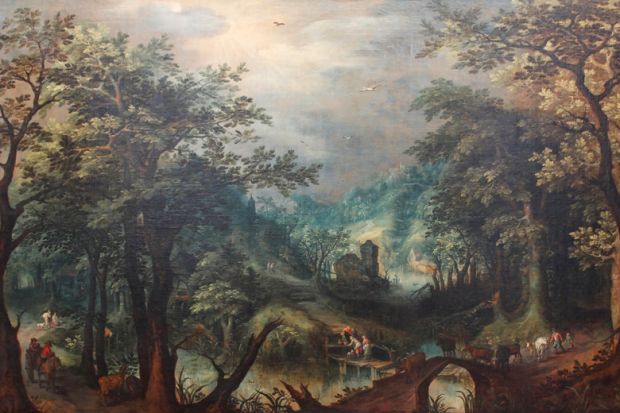To describe a book as enchanting is usually to condescend to it. Not this time. Fiona Stafford’s enchanting study is also stoutly built, plainly and stylishly written, admirably achieved as to both artistry and pedagogy, and as gripping as a good thriller, replete with plots and character.
She joins a recent throng of distinguished nature writers (if the slogan will pass) – Robert Macfarlane at its head no doubt, Richard Mabey, Anna Pavord, Oliver Rackham, Tim Dee – whose work is perhaps a sign that literary culture is joining itself to science in a response to the dreadful menace of headlong climate change threatening with extinction all the natural beauties and nourishment that tie together humanity’s body and souls.
Not that this is, even remotely, an apocalyptic work. It invites cheerful participation. “Here, listen,” I want to call out to her, “when we built our house on a bit of rough pasture on the top of the Mendips, we were preceded and are now guarded by two majestic beeches, two ditto chestnuts, an ash (still in good health, fearfully inspected by me for dieback, twice a week), a well-grown hazel and a towering larch. We added fruit and cherry trees, and our very own oak, now a vigorous teenager.”
For Stafford’s classic is a book with which to enter into a delighted and equal conversation. Of course its author is a person of enormous learning, in literature for sure (she is professor of the subject at the University of Oxford), in the natural history of trees it goes without saying, and also keenly alive to the rustling and murmur of political history beneath every leaf of her protean topic. In a chapter on the cypress (leylandii) tree she tells us, straight-faced, that the Anti-social Behaviour Act of 2003 was amended to resolve disputes between two neighbours, one of whom had resorted to direct action and unilaterally cut back towering hedges that shut out the sun and crowded the house. A glancing and ironic reference to Margaret Thatcher’s coming to power when Dutch elm disease wiped out that much-loved landmark finds an echo, for those who want to hear it, in a passing honour done to the Tolpuddle martyrs who foregathered under the giant sycamore in their Dorset village, thereby initiating, as the mythic history goes, the trade union movement.
For Stafford is not only a supremely cultivated scholar, but a writer and thinker vividly alive to trees in her own times and, trees being what they are, to the vast history and prehistory that stretches back beyond the shadowy bulk of this yew, this pine, this oak.
The organisation of her book is simple: one chapter, one tree; the argument of each chapter, to assemble all the author can of meaning in the annals of culture of each tree, to add to this her own loving and judicious commentary drawn from poetry and novels in many languages, painting – she includes 60 black-and-white but well-reproduced, sharply relevant illustrations – anthropology, Scripture and, of course, the literature of travel.
One way of responding to this marvellous book is to keep reading aloud to one’s patiently exasperated partner, “You didn’t know this and nor did I.” You didn’t know and are glad to know that extract of horse chestnut has been used to cure arachnophobia; that the archery regiment at Agincourt lived in fear of poisoning by its own longbows; that after 1945 the Koreans tore up all the thousands of cherry trees planted by the occupying Japanese army; that “birching” children with long, strong, twigs bound together was annulled as legal punishment in British schools only in 1948; that you are safe from all danger, especially of a supernatural sort, sitting under a rowan tree; that the Mosquito bomber, which at the hands of its master-bomber pilot led the RAF thousand-bomber raids of 1944 on to their targets, was made almost entirely of ash wood; that “Derry” is old Irish for “oak”.
Once one begins like this, it is very hard to stop. Birch tea reduces cholesterol and eases gout; in Puglia, some olive trees (ulivi secolari) are 5,000 years old; cypress is the wood of choice for church organs; Oak-Apple Day is still celebrated in Marsh Gibbon village (and where is that? you ask); Alan Turing killed himself with a poisoned apple; the poplar became the Liberty Tree because of Jean-Jacques Rousseau’s choice of the tree as phonetically close to populace; English willows, still grown for harvest in Somerset, are famous for providing wood for every cricket bat in the world, but it is less well known that only the female willow bears the right wood.
It should not, however, be thought that the way to treat Stafford’s book is for fact-packed reference. The thing lives and moves. She is at her ease with technical vocabulary and teaches us to be the same – mucilage, anthocyanins, taxanes; if you need to, look them up. She is accompanied by the poets every step of the way, Keats, Wordsworth and famous Seamus; she is just as much friends with the painters, Constable, Van Gogh, Millais’ inexcusably erotic Knight Errant with a naked maiden bound to a birch. But Stafford’s enormous subject is no less than our – humankind’s – sacred communion with the trees that fit us with furniture, teach us of natural beauty, symbolise our deepest allegiances, shape our movements through geography, and instruct us of the brevity of our lives, not theirs.
These noble lessons are rarely taught by scholars these days, but Stafford’s pedagogy is shaped with irreproachable tact. I don’t at all want to diminish my eulogy if I add a couple of minor objections. The first is to ask how she could omit the beech tree from her roll call. No doubt everyone would name a favourite missing from a list already 17-strong, but the beech, the shapely, towering, universal beech? The second omission, lightly touched but never tackled, is terror of trees. Pan is mentioned, but the great god’s terrible weapon, panic fear, omitted. This is odd, because Stafford mentions Der grüne Mann, but not his fearsome incarnation in Kingsley Amis’ ghost story, in which an abominable giant-shaped medley of oak, beech, yew and perdition knows what else lumbers abroad, crunching and crackling, looking for virgins to trample to death. Most trees have a face hidden in their bark; it is rarely a friendly one.
Maybe we have had enough of terrors these days, and in any case Stafford deals handsomely with the swift and shocking death of the good old elm. Beware farewells to any tree. In Puck of Pook’s Hill, the best of all children’s novels, Puck himself, a mysterious, kindly, remote and accessible figure, tells the two children who have accidentally summoned him from eternity: “I came into England with oak, ash and thorn, and when oak, ash and thorn are gone, I shall go too.” Dan, the little boy in the tale, looks at his sister Una’s oak and at the line of ash trees by the Otter Pool, and promises that he will plant plenty of acorns in the autumn.
Fiona Stafford has done the same for us.
Fred Inglis is honorary professor of cultural history, University of Warwick.
The Long, Long Life of Trees
By Fiona Stafford
Yale University Press, 296pp, £16.99
ISBN 9780300207330
Published 16 August 2016
The author

Asked what trees she can see from her window, and whether she would change any of them given the chance, Fiona Stafford names “a willow, an ash, a hornbeam and a young elm. I enjoy looking at all of them, although I would change the elm as it will soon die. All the local elms are infected with Dutch elm disease, which kills them before they can reach maturity. It is rather melancholy to think of that tree standing so little chance in the great struggle for existence.”
Stafford, professor of English language and literature at the University of Oxford, was born at RAF Scampton in Lincolnshire. “I lived in lots of places, until my family settled in Lincolnshire again when I was a teenager. As part of a large, close, excitable family and frequently a new girl at school, I think I became quite adaptable and alert to the distinctive features of a new environment. I am naturally friendly and interested in people and all sorts of different things, which may result in part from these childhood experiences. When we settled in our own home, it was in a tiny hamlet deep in a wood, so my love of trees was probably strengthened by the family’s collective sense of putting down roots.”
She took her first degree at the University of Leicester. “I was quite shy and homesick at first, but I soon made friends and enjoyed going out and discovering life. I loved reading and writing and learning, but I also contributed to the student newspaper and the arts magazine, as well as helping behind the scenes at the theatre and volunteering for various charitable organisations. By my final year, I had become so interested in my studies that I devoted most of my time to academic work.”
What gives her hope? “Students, poetry, friendship and trees. Oh, and acorns, secondhand bookshops, robins, rowing boats, lighthouses, lemon drizzle cake and the BBC.”
Karen Shook
后记
Print headline: The woods lovely, dark and deep




